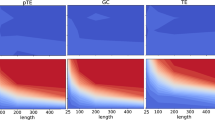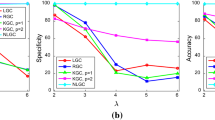Abstract
The Partial Directed Coherence (PDC) and its generalized formulation (gPDC) are popular tools for investigating, in the frequency domain, the concept of Granger causality among multivariate (MV) time series. PDC and gPDC are formalized in terms of the coefficients of an MV autoregressive (MVAR) model which describes only the lagged effects among the time series and forsakes instantaneous effects. However, instantaneous effects are known to affect linear parametric modeling, and are likely to occur in experimental time series. In this study, we investigate the impact on the assessment of frequency domain causality of excluding instantaneous effects from the model underlying PDC evaluation. Moreover, we propose the utilization of an extended MVAR model including both instantaneous and lagged effects. This model is used to assess PDC either in accordance with the definition of Granger causality when considering only lagged effects (iPDC), or with an extended form of causality, when we consider both instantaneous and lagged effects (ePDC). The approach is first evaluated on three theoretical examples of MVAR processes, which show that the presence of instantaneous correlations may produce misleading profiles of PDC and gPDC, while ePDC and iPDC derived from the extended model provide here a correct interpretation of extended and lagged causality. It is then applied to representative examples of cardiorespiratory and EEG MV time series. They suggest that ePDC and iPDC are better interpretable than PDC and gPDC in terms of the known cardiovascular and neural physiologies.
Similar content being viewed by others
Abbreviations
- DC:
-
Directed Coherence
- ECG:
-
ElectroCardioGram
- EEG:
-
ElectroEncephaloGram
- ePDC:
-
extended Partial Directed Coherence
- gPDC:
-
generalized Partial Directed Coherence
- HF:
-
High Frequency
- HP:
-
Heart Period
- iPDC:
-
Partial Directed Coherence measured from MVAR model with instantaneous effects
- LF:
-
Low Frequency
- MVAR:
-
MultiVariate AutoRegressive
- PDC:
-
Partial Directed Coherence
- RF:
-
Respiratory Flow
- SAP:
-
Systolic Arterial Pressure
References
Akaike H (1974) A new look at the statistical model identification. IEEE Trans Automat Contr 19: 716–723
Astolfi L, Cincotti F, Mattia D, Marciani MG, Baccala LA, De Vico FF, Salinari S, Ursino M, Zavaglia M, Babiloni F (2006) Assessing cortical functional connectivity by partial directed coherence: simulations and application to real data. IEEE Trans Biomed Eng 53: 1802–1812
Babiloni C, Binetti G, Cassarino A, Dal Forno G, Del Percio C, Ferreri F, Ferri R, Frisoni G, Galderisi S, Hirata K, Lanuzza B, Miniussi C, Mucci A, Nobili F, Rodriguez G, Luca RG, Rossini PM (2006) Sources of cortical rhythms in adults during physiological aging: a multicentric EEG study. Hum Brain Mapp 27: 162–172
Baccala LA, Sameshima K (2001) Partial directed coherence: a new concept in neural structure determination. Biol Cybern 84: 463–474
Baccala LA, Sameshima K, Ballester G, Valle AC, Timo-Iaria C (1998) Studying the interaction between brain structures via directed coherence and Granger causality. Appl Signal Process 5: 40–48
Baccala L, Sameshima K, Takahashi DY (2007) Generalized partial directed coherence. In: Proceedings of the 2007 15th international conference on digital signal processing pp 163–166
Baselli G, Cerutti S, Badilini F, Biancardi L, Porta A, Pagani M, Lombardi F, Rimoldi O, Furlan R, Malliani A (1994) Model for the assessment of heart period and arterial pressure variability interactions and of respiration influences. Med Biol Eng Comput 32: 143–152
Baselli G, Porta A, Rimoldi O, Pagani M, Cerutti S (1997) Spectral decomposition in multichannel recordings based on multivariate parametric identification. IEEE Trans Biomed Eng 44: 1092–1101
Bernasconi C, Konig P (1999) On the directionality of cortical interactions studied by structural analysis of electrophysiological recordings. Biol Cybern 81: 199–210
Brovelli A, Ding M, Ledberg A, Chen Y, Nakamura R, Bressler SL (2004) Beta oscillations in a large-scale sensorimotor cortical network: directional influences revealed by Granger causality. Proc Natl Acad Sci USA 101: 9849–9854
Chatfield C (1977) Some recent developments in time-series analysis. J R Stat Soc Ser A 140: 492–510
Cox DR (1981) Statistical analysis of time series: some recent developments. Scand J Stat 8: 93–115
Ding M, Bressler SL, Yang W, Liang H (2000) Short-window spectral analysis of cortical event-related potentials by adaptive multivariate autoregressive modeling: data preprocessing, model validation, and variability assessment. Biol Cybern 83: 35–45
Eichler M (2005) A graphical approach for evaluating effective connectivity in neural systems. Philos Trans Roy Soc B 360: 953–967
Erla S, Faes L, Tranquillini E, Orrico D, Nollo G (2009) Multivariate autoregressive model with instantaneous effects to improve brain connectivity estimation. Int J Bioelectromag 11(2): 74–79
Faes L, Porta A, Cucino R, Cerutti S, Antolini R, Nollo G (2004) Causal transfer function analysis to describe closed loop interactions between cardiovascular and cardiorespiratory variability signals. Biol Cybern 90: 390–399
Faes L, Widesott L, Del Greco M, Antolini R, Nollo G (2006) Causal cross-spectral analysis of heart rate and blood pressure variability for describing the impairment of the cardiovascular control in neurally mediated syncope. IEEE Trans Biomed Eng 53: 65–73
Faes L, Porta A, Nollo G (2009) Surrogate data approaches to assess the significance of directed coherence: application to EEG activity propagation. 31st Ann Int Conf IEEE Eng Med Biol Soc EMBC2009, pp 6280–6283
Geweke J (1982) Measurement of linear dependence and feedback between multiple time series. J Am Stat Assoc 77: 304–313
Gourevitch B, Bouquin-Jeannes RL, Faucon G (2006) Linear and nonlinear causality between signals: methods, examples and neurophysiological applications. Biol Cybern 95: 349–369
Granger CWJ (1969) Investigating causal relations by econometric models and cross-spectral methods. Econometrica 37: 424–438
Ito J, Nikolaev AR, van Leeuwen C (2005) Spatial and temporal structure of phase synchronization of spontaneous alpha EEG activity. Biol Cybern 92: 54–60
Kaminski M, Blinowska K, Szelenberger W (1995) Investigation of coherence structure and EEG activity propagation during sleep. Acta Neurobiol Exp (Wars) 55: 213–219
Kaminski M, Blinowska K, Szelenberger W (1997) Topographic analysis of coherence and propagation of EEG activity during sleep and wakefulness. Electroencephalogr Clin Neurophysiol 102: 216–227
Kaminski M, Ding M, Truccolo WA, Bressler SL (2001) Evaluating causal relations in neural systems: granger causality, directed transfer function and statistical assessment of significance. Biol Cybern 85: 145–157
Kay SM (1988) Modern spectral estimation. Theory & application. Prentice Hall, Englewood Cliffs, NJ
Koopmans LH (1974) The spectral analysis of time series. Academic Press, New York
Korhonen I, Mainardi L, Loula P, Carrault G, Baselli G, Bianchi A (1996) Linear multivariate models for physiological signal analysis: theory. Comput Methods Programs Biomed 51: 85–94
Li WK (2004) Diagnostic checks in time series. Chapman and Hall/CRC, Boca Raton, NY
Lutkepohl H (1993) Introduction to multiple time series analysis. Springer, Berlin
Malliani A, Pagani M, Lombardi F, Cerutti S (1991) Cardiovascular neural regulation explored in the frequency domain. Circulation 84: 482–492
Mullen TJ, Appel ML, Mukkamala R, Mathias JM, Cohen RJ (1997) System identification of closed loop cardiovascular control: effects of posture and autonomic blockade. Am J Physiol 272: H448–H461
Nollo G, Faes L, Porta A, Antolini R, Ravelli F (2005) Exploring directionality in spontaneous heart period and systolic pressure variability interactions in humans. Implications in baroreflex gain evaluation. Am J Physiol Heart Circ Physiol 288: H1777–H1785
Pereda E, Quiroga RQ, Bhattacharya J (2005) Nonlinear multivariate analysis of neurophysiological signals. Prog Neurobiol 77: 1–37
Pierce DA (1979) R-squared measures for time series. J Am Stat Assoc 74: 901–910
Pierce DA, Haugh LD (1977) Causality in temporal systems. J Econom 5: 265–293
Porta A, Furlan R, Rimoldi O, Pagani M, Malliani A, van de Borne P (2002) Quantifying the strength of the linear causal coupling in closed loop interacting cardiovascular variability signals. Biol Cybern 86: 241–251
Porta A, Aletti F, Vallais F, Baselli G (2009) Multimodal signal processing for the analysis of cardiovascular variability. Philos Transact A Math Phys Eng Sci 367: 391–409
Sato JR, Takahashi DY, Arcuri SM, Sameshima K, Morettin PA, Baccala LA (2009) Frequency domain connectivity identification: an application of partial directed coherence in fMRI. Hum Brain Mapp 30: 452–461
Saul JP, Berger RD, Chen MH, Cohen RJ (1989) Transfer function analysis of autonomic regulation. II. Respiratory sinus arrhythmia. Am J Physiol 256: H153–H161
Schelter B, Winterhalder M, Eichler M, Peifer M, Hellwig B, Guschlbauer B, Lucking CH, Dahlhaus R, Timmer J (2006) Testing for directed influences among neural signals using partial directed coherence. J Neurosci Methods 152: 210–219
Schlogl A, Supp G (2006) Analyzing event-related EEG data with multivariate autoregressive parameters. Prog Brain Res 159: 135–147
Shimizu S, Hoyer PO, Hyvarinen A, Kerminen A (2006) A linear non-Gaussian acyclic model for causal discovery. J Mach Learn Res 7: 2003–2030
Wehling S, Simion C, Shimojo S, Bhattacharya J (2007) Assessment of connectivity patterns from multivariate time series by partial directed coherence. Chaos Compl Lett 2: 413–433
Yang H, Chang JY, Woodward DJ, Baccala LA, Han JS, Luo F (2005) Coding of peripheral electrical stimulation frequency in thalamocortical pathways. Exp Neurol 196: 138–152
Author information
Authors and Affiliations
Corresponding author
Electronic Supplementary Material
Rights and permissions
About this article
Cite this article
Faes, L., Nollo, G. Extended causal modeling to assess Partial Directed Coherence in multiple time series with significant instantaneous interactions. Biol Cybern 103, 387–400 (2010). https://doi.org/10.1007/s00422-010-0406-6
Received:
Accepted:
Published:
Issue Date:
DOI: https://doi.org/10.1007/s00422-010-0406-6




